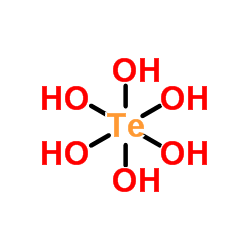Tellurium (IV) iodide

Tellurium (IV) iodide structure
|
Common Name | Tellurium (IV) iodide | ||
|---|---|---|---|---|
| CAS Number | 7790-48-9 | Molecular Weight | 635.21800 | |
| Density | 5.05 g/mL at 25 °C(lit.) | Boiling Point | N/A | |
| Molecular Formula | I4Te | Melting Point | 280°C | |
| MSDS | N/A | Flash Point | N/A | |
| Name | Tellurium tetraiodide |
|---|---|
| Synonym | More Synonyms |
| Density | 5.05 g/mL at 25 °C(lit.) |
|---|---|
| Melting Point | 280°C |
| Molecular Formula | I4Te |
| Molecular Weight | 635.21800 |
| Exact Mass | 637.52400 |
| LogP | 3.16200 |
|
Section 1: Product Identification Chemical Name:Tellurium (IV) iodide (99.9%-Te) CAS Registry Number:7790-48-9 Formula:TeI4 EINECS Number:232-210-5 Chemical Family:metal halide Synonym:Tellurium tetraiodide.
Section 2: Composition and Information on Ingredients IngredientCAS NumberPercentACGIH (TWA)OSHA (PEL) Title Compound7790-48-9100%0.1mg/m3 (as Te)0.1mg/m3 (as Te) Section 3: Hazards Identification Causes severe skin, eye and respiratory tract irritation with cough, breathing difficulty, nausea and vomiting. Emergency Overview: Prolonged exposure may produce a mild toxic syndrome known as iodism. Primary Routes of Exposure:Contact with skin and eyes. Inhalation of dust. Eye Contact:Causes redness, pain, and blurred vision. Splashes from solutions may cause eye damage. Skin Contact:Causes severe irritation, ulcerations, itching, pimples, boils, hives, blisters and skin burns. Inhalation:Causes irritation to the respiratory tract. Symptoms may include coughing and shortness of breath. Ingestion:May cause severe irritation to the gastrointestinal tract with abdominal pain, nausea, and vomiting. May cause coughing, nausea, and vomiting. Skin and eye contact will cause severe irritation. Tellurium may Acute Health Affects: cause garlic odor of breath, metallic taste, sleepiness, headache and nausea. Chronic ingestion of iodides may produce iodism. Symptoms include skin rash, running nose, headache and Chronic Health Affects:irritation of mucous membranes. Prolonged exposure to tellurium may cause drowsiness and loss of appetite. NTP:No IARC:No OSHA:No SECTION 4: First Aid Measures Immediately flush the eyes with copious amounts of water for at least 10-15 minutes. A victim may need Eye Exposure: assistance in keeping their eye lids open. Get immediate medical attention. Wash the affected area with water. Remove contaminated clothes if necessary. Seek medical assistance if Skin Exposure: irritation persists. Remove the victim to fresh air. Closely monitor the victim for signs of respiratory problems, such as difficulty Inhalation: in breathing, coughing, wheezing, or pain. In such cases seek immediate medical assistance. Seek medical attention immediately. Keep the victim calm. Give the victim water (only if conscious). Induce Ingestion: vomiting only if directed by medical personnel. SECTION 5: Fire Fighting Measures Flash Point:not applicable Autoignition Temperature:none Explosion Limits:none Extinguishing Medium:None. Material is non-flammable. Special Fire Fighting Procedures:No special fire fighting procedures required. Hazardous Combustion andnone Decomposion Products: Unusual Fire or Explosion Hazards: No unusual fire or explosion hazards. SECTION 6: Accidental Release Measures Small spills can be mixed with powdered sodium bicarbonate, lime, or calcium carbonate and swept up. Avoid Spill and Leak Procedures: raising dust. SECTION 7: Handling and Storage Store solid in a tightly sealed container away from moisture. Handle in a fume hood under a dry atmosphere of Handling and Storage: air or nitrogen. Prolonged exposure to the atmosphere may degrade the product. SECTION 8: Exposure Controls and Personal Protection Eye Protection:Always wear approved safety glasses when handling a chemical substance in the laboratory. Skin Protection:Wear protective clothing and gloves. Consult with glove manufacturer to determine the proper type of glove. Ventilation:Material may form a fine dust. If possible, handle the material in an efficient fume hood. If in form of fine dust and ventilation is not available a respirator should be worn. The use of respirators Respirator: requires a Respirator Protection Program to be in compliance with 29 CFR 1910.134. Ventilation:Material may form a fine dust. If possible, handle the material in an efficient fume hood. Additional Protection:No additional protection required. SECTION 9: Physical and Chemical Properties Color and Form:-4 mesh gran. Molecular Weight:635.22 Melting Point:280° Boiling Point:no data Vapor Pressure:no data Specific Gravity:5.403 Odor:none Solubility in Water:slightly soluble SECTION 10: Stability and Reactivity Stability:moisture sensitive Hazardous Polymerization:no hazardous polymerization Conditions to Avoid:contact with moisture Incompatibility:active metals Decomposition Products:none SECTION 11: Toxicological Information RTECS Data:No information available in the RTECS files. Carcinogenic Effects:no data Mutagenic Effects:no data Tetratogenic Effects:no data SECTION 12: Ecological Information Ecological Information:No information available SECTION 13: Disposal Considerations Disposal:Dispose of according to local, state and federal regulations. SECTION 14: Transportation Shipping Name (CFR):Non-hazardous Hazard Class (CFR):NA Additional Hazard Class (CFR):NA Packaging Group (CFR):NA UN ID Number (CFR):NA Shipping Name (IATA):Non-hazardous Hazard Class (IATA):NA Additional Hazard Class (IATA):NA Packaging Group (IATA):NA UN ID Number (IATA):NA SECTION 15: Regulatory Information TSCA:Listed in the TSCA inventory SARA (Title 313):Not reportable under SARA 313. Second Ingredient:none SECTION 16 - ADDITIONAL INFORMATION N/A |
| Hazard Codes | C |
|---|---|
| Risk Phrases | 20/21/22-34 |
| Safety Phrases | S22-S26-S27-S36/37/39-S45 |
| RIDADR | UN 3260 8/PG 2 |
| WGK Germany | 3 |
| Packaging Group | II |
| Hazard Class | 8 |
|
~% 
Tellurium (IV) ... CAS#:7790-48-9 |
| Literature: Ann. Chim. Phys., , vol. 58, p. 272 - 272 Annalen der Physik (Weinheim, Germany), , vol. 32, p. 619 - 619 |
|
~% 
Tellurium (IV) ... CAS#:7790-48-9 |
| Literature: Z. Anorg. Chem., , vol. 32, p. 110 - 110 |
|
~% 
Tellurium (IV) ... CAS#:7790-48-9 |
| Literature: Z. Anorg. Chem., , vol. 13, p. 169 - 169 |
|
~0%
Detail
|
| Literature: Annalen der Physik (Weinheim, Germany), , vol. 32, p. 622 - 622 Z. Anorg. Chem., , vol. 32, p. 110 - 110 |
|
~% 
Tellurium (IV) ... CAS#:7790-48-9 |
| Literature: Bulletin de la Societe Chimique de France, , p. 886 - 888 Te: SVol.B1, 2.2.8.4, page 58 - 72 |
|
~% 
Tellurium (IV) ... CAS#:7790-48-9 |
| Literature: Inorganic Materials, , vol. 43, # 9 p. 1018 - 1023 |
|
~% 
Tellurium (IV) ... CAS#:7790-48-9 |
| Literature: Zeitschrift fuer Anorganische und Allgemeine Chemie, , vol. 461, p. 165 - 172 |
| Precursor 8 | |
|---|---|
| DownStream 5 | |
| TELLURIUM(IV) IODIDE |
| EINECS 232-210-5 |
| tellurium iodide |
| tetraiodo-|E4-tellane |
| MFCD00049578 |
| Tellur(IV) iodid |









 CAS#:7782-68-5
CAS#:7782-68-5 CAS#:7784-45-4
CAS#:7784-45-4
